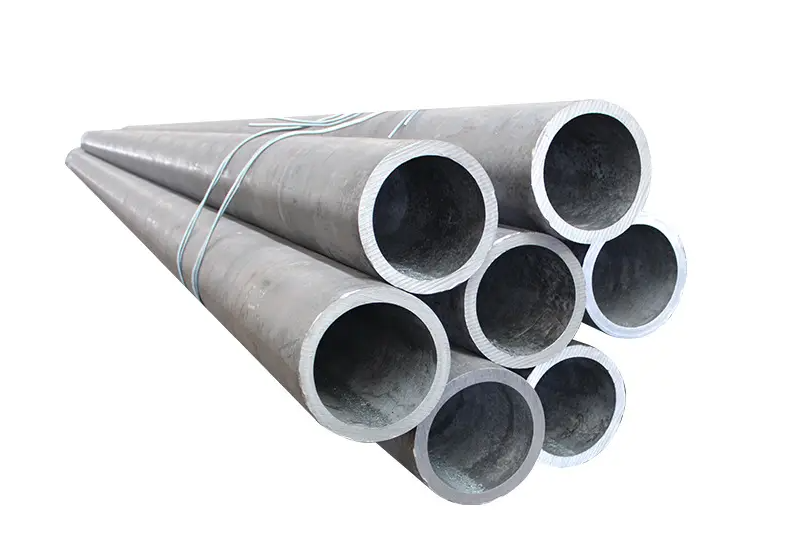ASTM A333 Steel Pipe

ASTM A333 Steel Pipe
Introduction
ASTM A333 is a standard specification for seamless and welded steel pipes designed for low-temperature service. These pipes are used in environments where temperatures can drop significantly, making them suitable for applications in cryogenic and low-temperature settings. ASTM A333 pipes are known for their excellent toughness and durability, even at extremely low temperatures.
Grades of ASTM A333
ASTM A333 includes several grades, each with specific chemical compositions and mechanical properties:
- Grade 1
- Grade 3
- Grade 4
- Grade 6
- Grade 7
- Grade 8
- Grade 9
- Grade 10
- Grade 11
Among these, Grade 6 is the most commonly used grade.
| Specifications | Range |
| Out Diameter | 1/4″- 48″ |
| Wall Thickness | Schedules 40 through 160, STD, XS, XXS. |
Standard: ASME SA 335 American society of mechanical engineers; ASTM A335M American society for Testing and Materials
Uses: For manufacture wall panel, economizer, reheater, superheater and steam pipeline of boilers.
| Grade | UNS Designation | Composition, % | ||||||
| Carbon | Manganese | hosphorus (max) | Sulfur (max) | Silicon | Chromium | Molybdenum | ||
| P1 | K11522 | 0.10–0.20 | 0.30–0.80 | 0.025 | 0.025 | 0.10–0.50 | – | 0.44–0.65 |
| P2 | K11547 | 0.10–0.20 | 0.30–0.61 | 0.025 | 0.025 | 0.10–0.30 | 0.50–0.81 | 0.44–0.65 |
| P5 | K41545 | 0.15 max | 0.30–0.60 | 0.025 | 0.025 | 0.50 max | 4.00–6.00 | 0.44–0.65 |
| P9 | S50400 | 0.15 max | 0.30–0.60 | 0.025 | 0.025 | 0.25–1.00 | 8.00–10.00 | 0.90–1.10 |
| P11 | K11597 | 0.05–0.15 | 0.30–0.60 | 0.025 | 0.025 | 0.50–1.00 | 1.00–1.50 | 0.44–0.65 |
| P12 | K11562 | 0.05–0.15 | 0.30–0.61 | 0.025 | 0.025 | 0.50 max | 0.80–1.25 | 0.44–0.65 |
| P15 | K11578 | 0.05–0.15 | 0.30–0.60 | 0.025 | 0.025 | 1.15–1.65 | – | 0.44–0.65 |
| P21 | K31545 | 0.05–0.15 | 0.30–0.60 | 0.025 | 0.025 | 0.50 max | 2.65–3.35 | 0.80–1.06 |
| P22 | K21590 | 0.05–0.15 | 0.30–0.60 | 0.025 | 0.025 | 0.50 max | 1.90–2.60 | 0.87–1.13 |
| P23 | K41650 | 0.04–0.10 | 0.10–0.60 | 0.03 | 0.01 | 0.50 max | 1.90–2.60 | 0.05–0.30 |
| P91 | K91560 | 0.08–0.12 | 0.30–0.60 | 0.02 | 0.01 | 0.20–0.50 | 8.00–9.50 | 0.85–1.05 |
| P92 | K92460 | 0.07–0.13 | 0.30–0.60 | 0.02 | 0.01 | 0.50 max | 8.50–9.50 | 0.30–0.60 |
Chemical Composition
The chemical composition of ASTM A333 Grade 6 pipe is typically as follows:
- Carbon (C): ≤ 0.30%
- Manganese (Mn): 0.29 – 1.06%
- Phosphorus (P): ≤ 0.025%
- Sulfur (S): ≤ 0.025%
- Silicon (Si): 0.10 – 0.50%
Other grades may have slight variations in their chemical compositions to enhance specific properties.
Mechanical Properties
The mechanical properties of ASTM A333 pipes are crucial for ensuring performance in low-temperature environments. For Grade 6, the properties include:
- Tensile Strength: ≥ 415 MPa (60,000 psi)
- Yield Strength: ≥ 240 MPa (35,000 psi)
- Elongation: ≥ 30% (in 2 inches or 50 mm)
These properties ensure that the pipes can withstand the stresses and strains encountered in low-temperature applications.
Manufacturing Process
ASTM A333 pipes can be manufactured using either seamless or welded processes:
Seamless Pipes
- Hot-Finished Seamless: Pipes are formed through hot-working processes and then cooled to achieve the desired mechanical properties.
- Cold-Finished Seamless: Pipes undergo additional cold-working processes, such as cold drawing, to enhance dimensional accuracy and surface finish.
Welded Pipes
- Electric Resistance Welded (ERW): Pipes are formed by welding the edges of steel plates or strips using electric resistance.
- Double Submerged Arc Welded (DSAW): Pipes are formed by welding both the internal and external seams using submerged arc welding.
Heat Treatment
Depending on the grade and manufacturing process, ASTM A333 pipes may undergo various heat treatment processes, such as:
- Normalizing: Heating the pipe to a specific temperature and then cooling it in air to refine the grain structure.
- Quenching and Tempering: Rapidly cooling the pipe in water or oil and then reheating it to a lower temperature to achieve the desired mechanical properties.
Testing Requirements
ASTM A333 specifies several tests to ensure the quality and performance of the pipes:
- Tensile Test: Measures the tensile strength, yield strength, and elongation.
- Impact Test: Conducted at low temperatures (e.g., -50°F or -45°C) to assess the toughness of the material.
- Hydrostatic Test: Ensures the pipe can withstand internal pressure without leaking.
- Non-Destructive Testing (NDT): Methods such as ultrasonic testing (UT) or radiographic testing (RT) are used to detect internal flaws.
Applications
ASTM A333 pipes are used in various industries and applications where low-temperature service is required:
- Cryogenic Applications: Storage and transport of liquefied gases such as LNG, LPG, and liquid nitrogen.
- Oil and Gas Industry: Pipelines and processing facilities operating in arctic or sub-zero environments.
- Petrochemical Industry: Equipment and piping systems in low-temperature chemical processing.
- Power Generation: Piping systems in power plants, especially in regions with cold climates.
- Marine Applications: Structures and piping on ships and offshore platforms operating in cold seas.
Conclusion
ASTM A333 steel pipes are essential for applications requiring reliable performance at low temperatures. Their excellent mechanical properties, combined with rigorous manufacturing and testing processes, ensure they meet the demanding requirements of various industries. Understanding the specifications, grades, and applications of ASTM A333 pipes helps engineers and designers select the right materials for their projects, ensuring safety and efficiency in low-temperature environments.
This guide provides a comprehensive overview of ASTM A333 steel pipes, covering their grades, chemical composition, mechanical properties, manufacturing processes, testing requirements, and applications.







